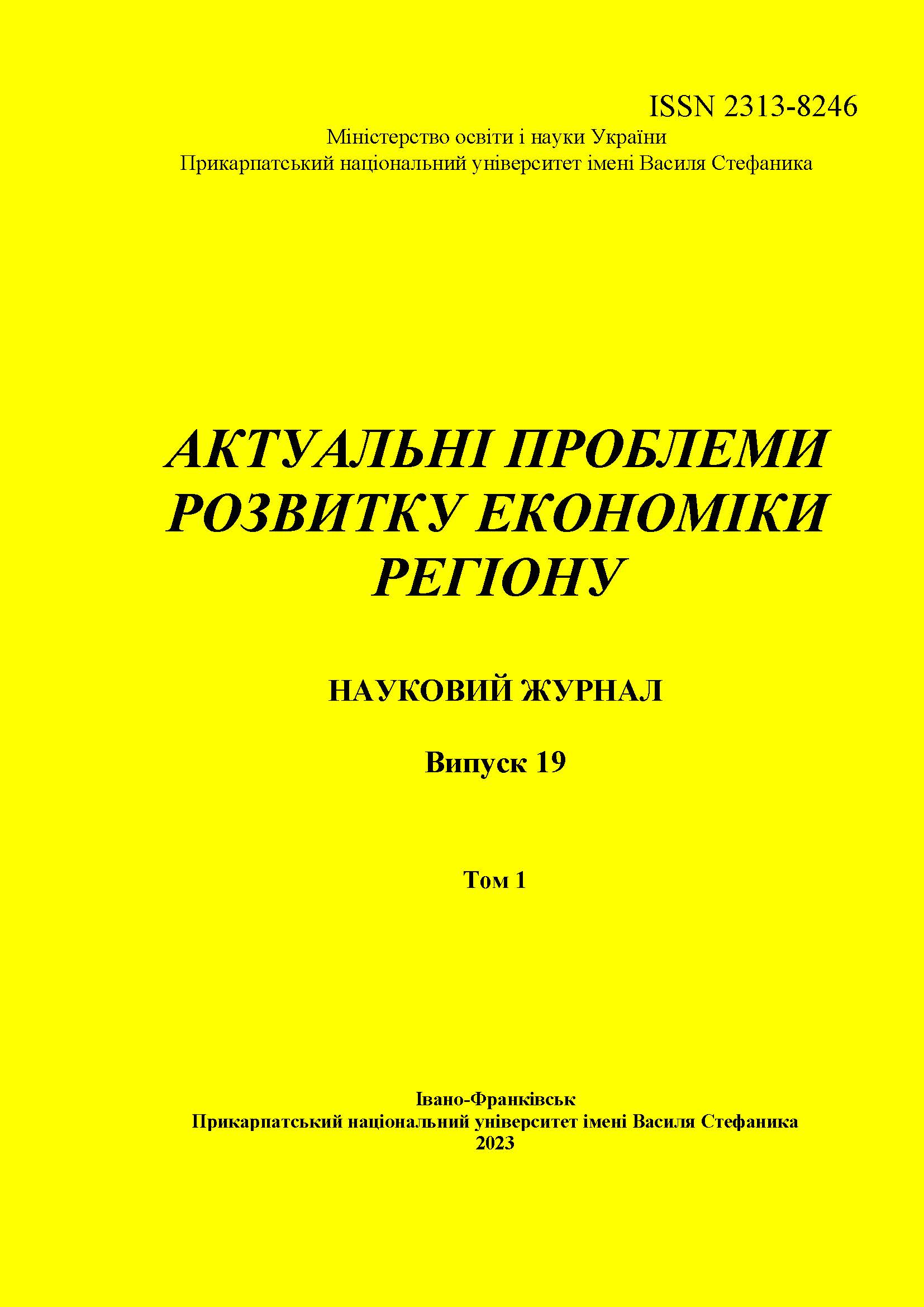CIRCULAR ECONOMY MODEL IN INDUSTRIAL ECOSYSTEMS
DOI:
https://doi.org/10.15330/apred.1.19.243-254Keywords:
transformation, industrial ecosystems, circular economy, concept, circular ecological and economic cycle, business modelAbstract
The purpose of the article is to determine the stages, mechanisms and competitive advantages of the transformation of industrial ecosystems to the circular economy model.
The methodological basis of the research is the method of scientific knowledge and system approach, comparison, analytical method, as well as dialectical, structural and functional methods. It has been proven that a closed ecological and economic cycle includes the achievement of sustainable economic growth through the use of global resources and the reuse of materials.
It was determined that in the circular economy, companies develop integrated supply chains, using resources more efficiently and creating new markets. The stages of the organization of the reconstruction of ecosystems: the assessment of ecosystem readiness and its transformation are considered, it is found that innovative technologies contribute to the systemic implementation of changes. The transformation of ecosystems is carried out with the help of mechanisms for limiting early investment costs, investing in IT infrastructure, and encouraging stakeholders to cooperate. It is proven that the riskiness of the transformed business model forces the parties to agree on the distribution of risks and revenues.
The principles of a circular ecological and economic cycle, which is based on circular development and reuse of waste, were proposed. The basis of the proposed scheme of principles reconstructs a simple economic linear scheme, which was previously based on the principles of "extracted - processed - consumed - discarded waste". To change the linear economy to the economy of a circular ecological and economic cycle, there is a need to ensure the maximum efficiency of each stage of the life cycle of a product or service. As part of the development of the circular ecological-economic cycle economy model, a conceptual approach to the introduction of a circular economy in Ukraine was proposed.
The transformation of industrial ecosystems can provide enterprises with various competitive advantages. Among the most common strategic advantages are differentiation and cost leadership. However, the main benefit of ecosystem transformation is to enhance the ability of ecosystems to achieve good triple bottom line outcomes, delivering social, financial and environmental benefits to clients. In particular, companies achieve higher productivity, better use of resources, reduction of hazardous jobs, greater transparency of the ecosystem, market growth and financial returns. The transformation of the ecosystem to a circular economy model creates opportunities for the development of sustainable industry.
References
2. “Accenture Strategy: Circular Advantage – Innovative Business Models and Technologies to Create Value in a World Without Limits to Grow”, www.accenture.com/t20150523t053139w/usen/_acnmedia/accenture/conversionassets/dotcom/documents/global/pdf/strategy_6/accenture-circular advantageinnovative-business-models-technologies-value-growth.pdf. Accessed 14 February 2023.
3. “Best European waste management practices”, epl.org.ua/wpcontent/uploads/2019/07/Krashchi_ES_praktuku_NET.pdf. Accessed 15 March 2023.
4. “Blue economy”, ru.qwe.wiki/wiki/Blue_economy?ddexp4attempt=1. Accessed 14 March 2023.
5. Bocken, N.M.P., Olivetti, E.A., Cullen, J.M., Potting, J. , and R Lifset. “Taking the Circularity to the Next Level: A Special Issue on the Circular Economy”, publications.eng.cam.ac.uk/907388/. Accessed 15.03.2023.
6. Center for ecological solutions. “Cradle to cradle concept”, ecoidea.by/ru/article/1166. Accessed 17.03.2023.
7. “Circular economy. Organizational and legal aspects”, www.businesslaw.org.ua/circle-economic-t/. Accessed 15 March 2023.
8. “Circular economy update. Overview of circular economy in Europe”. Final report. Ecopreneur.eu, circulareconomy.europa.eu/platform/sites/default/files/ecopreneur-circulareconomy-update-report-2019.pdf. Accessed 14 March 2023.
9. European Commission. “Circular economy”, ec.europa.eu/growth/industry/sustainability/ circular-economy_en. Accessed 16 March 2023.
10. European Commission. Eurostat. “Circular Economy”, ec.europa.eu/eurostat/web/circular-economy/indicators/main-tables. Accessed 14 March 2023.
11. Fletcher, K. Sustainable fashion and textiles: design journeys, Second; 2; edn, Earthscan from Routledge/Taylor & Francis Group, London. URL:_Sustainable_fashion_and_textiles_Design_journeys. Accessed 11 March 2023.
12. Ghisellini, P., Cialani, C., Ulgiati, S. A review on circular economy: the expected transition to a balanced interplay of environmental and economic systems. Elsevier Ltd. Journal of Cleaner Production S, www.academia.edu/20541707. Accessed 19 March 2023.
13. Khomenko, O.V. Circular economy is the basis of sustainable development of the People's Republic of China, sinologist.com.ua/homenko-o-v-tsyrkulyarna-ekonomika- osnova-stalogo-rozvytku-knr/. Accessed 15 March 2023.
14. MacArthur Foundation: “Towards a Circular Economy: Business Rationale For An Accelerated Transition”, www.ellenmacarthurfoundation.org/assets/downloads/TCE_EllenMacArthur-Foundation-9-Dec-2015.pdf. Accessed 23 March 2023.
15. “On approval of the National Waste Management Plan until 2030”, zakon.rada.gov.ua/laws/show/117-2019-р. Accessed 23 March 2023.
16. Roleders, V.V. “Evolution of the concept of circular economy and its essential characteristics.” Materials of the III International Forum of Scientists and Researchers "Science and Study 2021", October 1, Association for the Promotion of Globalization of Education and Science "SPACETIME", Kyiv, Ukraine, pp. 269–272.
17. Romanova, K., Tsybka, M. “Towards a closed cycle economy. Economy and Ecology”. Environment, recpc.kpi.ua/images/eap_green/printed_materials/Circular_EconomyEcolog y_of_enterprise.pdf. Accessed 11 March 2023.
18. “The Biosphere Rules”, en.m.wikipedia.org/wiki/The_Biosphere_Rules. Accessed 11 March 2023.
19. Tutov, S. What is a closed cycle economy and why is it the future, ua.112.ua/statji/shcho-take-ekonomika-zamknutoho-tsiklu-i-chomu-za-neiu-maibutnie-362569.html. Accessed 19.03.2023.
20. Vergunova, N.S. “Theoretical explanations of biomimetics on the example of architectural objects”, vestnik_construction.com.ua/images/pdf/4_90_2017/4.pdf. Accessed 11 March 2023.
21. Roleders, V., Oriekhova, T., & I.Sysoieva. “Trends in a Global Circular Economy”. Management Theory and Studies for Rural Business and Infrastructure Development, no.44(2), 2022, pp.176-184. doi.org/10.15544/mts.2022.18
Downloads
Published
Issue
Section
License
- Authors retain copyright and grant the journal right of first publication with the work simultaneously licensed under a Creative Commons Attribution NonCommercial NoDerivs 4.0 Unported License that allows others to share the work with an acknowledgement of the work's authorship and initial publication in this journal.
- Authors are able to enter into separate, additional contractual arrangements for the non-exclusive distribution of the journal's published version of the work (e.g., post it to an institutional repository or publish it in a book), with an acknowledgement of its initial publication in this journal.
- Authors are permitted and encouraged to post their work online (e.g., in institutional repositories or on their website) prior to and during the submission process, as it can lead to productive exchanges, as well as earlier and greater citation of published work (See The Effect of Open Access)


